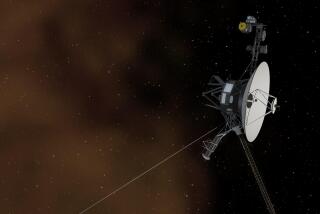NASA’s planet-hunting Kepler telescope disabled
- Share via
Planet-hunting scientists were dealt a major blow Wednesday when NASA officials announced that a crucial wheel on the Kepler space telescope had ceased to function and that the craft had been placed in safe mode.
Even as NASA officials raised the possibility that they could get the telescope back up and running, scientists began mourning the potential loss of a spacecraft that they said had fundamentally altered our understanding of alien planets in the Milky Way — and Earth’s place in an increasingly crowded galaxy.
“Tears are coming to my eyes on and off,” said UC Berkeley astrophysicist Geoff Marcy, a co-investigator on the Kepler mission. “I really think this telescope was a gift to our civilization.”
With more than 2,700 candidate planets identified and 132 confirmed since its 2009 launch, the Kepler telescope revolutionized scientists’ appreciation of the number and variety of so-called exoplanets, the bodies that orbit other stars, Marcy said. Its initial 3.5-year mission was extended last year through 2016.
The telescope works by staring at a patch of sky and watching for barely noticeable dips in distant starlight. Those dips are the result of shadows cast by planets as they pass in front of their parent stars.
At first, the biggest planets were easiest to find. As Kepler collected more data, it was able to identify smaller — and potentially more Earth-like — planets, including some in the habitable zone that are just the right distance to potentially bear liquid water, a necessary ingredient for life as we know it.
But even as Kepler racked up finds, it was running into trouble. One of its four reaction wheels failed nearly a year ago. Together, the wheels help point the spacecraft in the right direction.
The space telescope was able to continue its mission until a second reaction wheel seriously malfunctioned this month. On Tuesday, the wheel failed to respond to commands during a twice-weekly routine check-in.
Without at least three reaction wheels to control the spacecraft in three-dimensional space, Kepler was unable to point at a distant target with its once-formidable accuracy. That renders it essentially useless for hunting planets by watching for their transits in front of stars, scientists said.
This issue wasn’t entirely unexpected, said John Grunsfeld, associate administrator of NASA’s science mission directorate.
“We have some history with these wheels by this manufacturer, that they have a limited lifetime,” Grunsfeld said.
“Kepler’s not in a place where I can go up and rescue it,” the former astronaut said. Still, he added, “I wouldn’t call Kepler down and out just yet.”
Grunsfeld said there might be a chance that, with a little bit of high-tech jiggling, engineers could get the wheel working again.
In the meantime, the telescope was put into safe mode before a planned transition into a low-fuel mode called “point rest state,” officials said. That will allow the spacecraft to stay in fairly constant contact with Earth while mission engineers explore their options.
If the wheel stays stuck, it’s possible that Kepler could have other as-yet-undetermined scientific uses, officials said.
“We’re just going to have to wait and see what the performance of the vehicle is going to be,” said Charles Sobeck, the mission’s deputy project manager at Ames Research Center in Mountain View, Calif.
Though NASA officials insisted that Kepler was not yet dead, they looked toward future exoplanet-hunting efforts. The Transiting Exoplanet Survey Satellite, or TESS, will use a similar method to Kepler to find nearby exoplanets after its scheduled launch in 2017; and the James Webb Space Telescope, set to launch in 2018, will use its infrared vision to scan TESS’ finds for signs of organic molecules.
“This isn’t our last exoplanet mission — it’s our first exoplanet mission,” said Paul Hertz, NASA’s astrophysics director.
Mission lead scientist William Borucki at Ames Research Center expressed satisfaction at a job well done.
“I’m not feeling sorry at all,” Borucki said. “I’m feeling delighted — and happy — with what we’ve done.”
Scientists who had followed the mission — as well as those who participated in it — were less sanguine Wednesday.
“It’s nice that our NASA managers have correctly characterized the enormous success of the Kepler mission and are putting on a happy face,” Marcy said. “But I’m very deeply saddened and I think we’ve lost something precious here.”
Caltech planetary astronomer John Johnson expressed disappointment that his group would not be able to study more red dwarf systems, whose habitable zones are close to their cool parent stars and would make ideal candidates to look for Earth-like planets.
“It feels like an opportunity slipped through our hands,” he said.
Still, Kepler has made an important contribution to science by showing that there are far more planets around stars than scientists had ever imagined.
“That’s way bigger than anybody would have dared to dream,” Johnson said.
Even if Kepler isn’t able to continue its search, it has already sent back enough data to keep scientists busy for two more years, Borucki said.







